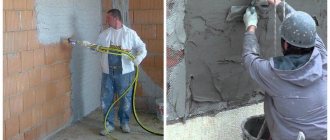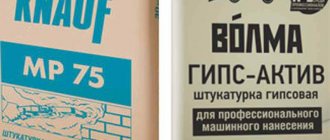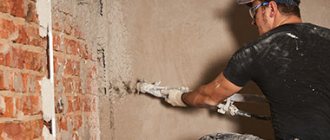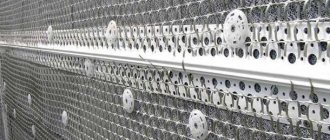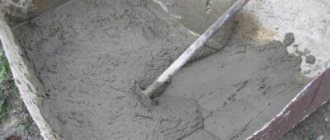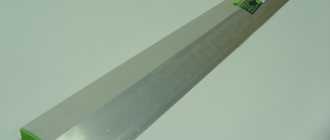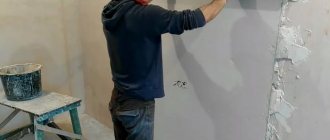Since its inception, humanity has always strived to make work easier in any way. For this reason, production means are constantly being modernized, and the best designers and scientists periodically offer newer and newer models of various equipment, including 220V mini plastering stations.
Therefore, the construction industry, in which the share of manual labor prevails, also did not stand aside.
In the photo - a mini plastering station on wheels
Why is there no alternative to machine plastering of walls?
The higher the level of automation and mechanization of production processes, the higher the productivity and quality of work performed. Plastering work is no exception, but despite the obvious benefits, for a long time this process was carried out exclusively by hand.
This is partly due to the lack of special machines, and most importantly, the need to use special compositions, which were not always possible to produce from traditional types of components.
But the real revolution occurred with the advent of universal type dry mixes, used for both manual and mechanized application, and also intended exclusively for plastering machines.
Of course, a plastering station for sand-cement mortar can also be used, but in this case it is important to strictly adhere to the proportions in order to ensure that the mixture is supplied with the appropriate consistency.
As a rule, the fact that the solution is prepared correctly can be judged by the following subjective factor: when applied, the composition does not splash and adheres tightly to the surface.
As a result, it is possible to optimize the production process for leveling walls using plaster, but at the same time eliminate the two most labor-intensive stages: preparing the solution and applying it to the surface.
Further, it is impossible to do without manual labor: the alignment itself is done manually. But it should be borne in mind that in this case larger areas are processed simultaneously, due to which a better result is achieved. When manually plastering walls, you have to work in parts and connect areas with different degrees of drying.
In addition, it is very difficult to achieve an identical composition of the mortar when mixing it manually - as a result, such plaster will always be inferior to mechanized plaster in both strength and quality.
Undoubtedly, for small areas, manual processing will in any case take place, but if we are talking about repairing at least one room, the use of the machine method is completely justified.
Advantages of the method
What is an automatic plastering machine?
The use of automatic plastering machines has many advantages:
- Mechanized devices help complete the application process many times faster than manually;
- They are economical, namely: two workers are enough for work, which allows you to save money for salaries; one machine can easily replace a whole team of workers;
- There is a saving of solution during operation; when preparing it in a machine, the mixture is saturated with air, which creates additional volume;
- The machine applies a much thinner layer of plaster than can be done by hand. This in turn guarantees a high-quality and durable coating;
- By mixing the solution with a machine, the mixture obtains the desired homogeneity and consistency;
- It is distinguished by the very rapid adhesion of the plaster to the surface due to the machine preparation of the solution.
What is better - machine plastering or hand plastering?
Plastering surfaces has long remained one of the most important types of construction work, the main distinguishing feature of which was the labor-intensive process associated with the need to use a large amount of manual labor, and, what is very important, highly professional. Otherwise, achieving even an acceptable result is quite difficult.
Machine plaster is used both for facade finishing and indoors. It can be used both when performing work on large objects and in an ordinary city apartment.
As a result of using this method of applying the plaster composition to the surfaces being treated, it is possible to achieve:
- significant reduction in work completion time (on average 3-5 times). This is mainly achieved due to the continuous process of making the solution and its application to the surface, as well as due to a reduction in the number of layers, since with the mechanization of the process, the mixture can be applied in a thicker layer, which allows you to quickly eliminate unevenness;
- reducing the amount of manual labor and, accordingly, reducing the cost of paying for it, which covers the cost of renting plastering equipment several times;
- the finished surface is characterized by almost perfect evenness, while better adhesion is ensured due to the fact that the solution is supplied under pressure. As a result, such plaster is devoid of voids, which means that cracks or peeling are less likely to appear on it;
- Although a surface plastered in this way requires grouting, this operation is greatly simplified, since in most cases the quality of the finish is quite acceptable even for wallpapering walls. Often, mechanized plaster for painting is used as a base layer for facade work, reducing their cost and, importantly, without loss of quality;
- due to the fact that it is possible to apply a thicker layer of mortar using a machine, as a rule, it is possible to level the walls immediately, which cannot be achieved with the manual option;
- a significant reduction in the amount of materials due to the fact that when preparing the solution it is actively enriched with air and, accordingly, its volume increases. With an average consumption of 16 kg/m2, with a manual application method, the mechanized version allows you to reduce these figures to 12-13 kg/m2. In addition, it should be taken into account that manual plastering will have to be done in at least 2 layers, and this is an additional cost.
Taking into account the fact that machine-applied gypsum plaster , it is quite possible to talk about the environmental friendliness of this method, since this material is absolutely safe and has good vapor permeability.
Instructions for mechanized plastering of walls, video:
Making your own unit from a fire extinguisher
If it is not possible to buy an automatic machine, and renting it is also problematic, then you can make such a machine yourself. Of course, it will have less power, but it will perform the basic functions of a plastering machine.
An ordinary fire extinguisher with a volume of about 4 liters will help us, because it is equipped with all the parts necessary for work: a valve for releasing the solution and a cylinder. First, we cut off the bottom; the container will serve as a container for the solution. Such a homemade unit will work on the principle of a spray gun. Also, for work we need a compressor that will supply air. To do this, you need to make a hole in the cylinder and install a metal tube with a nozzle there. Do-it-yourself plastering machine in the video at the end of the article.
Mechanisms and machines for plastering
Man has always strived to minimize the amount of manual labor, especially when performing labor-intensive and monotonous types of work. Therefore, the choice of mechanisms for plastering is quite large.
They differ in performance and, of course, price. Therefore, if you plan to do the work yourself, then it is not advisable to purchase expensive mechanisms.
In this case, you can consider renting a tool or buying a portable variety, such as a plastering gun or an air gun.
Craftsmen sometimes in such cases are inventors themselves and make homemade devices, while simultaneously finding a use for the available compressor, which is used to pump air into the solution and then supply it to the surface being treated.
Plastering machines: sizes, classes, types of operations
The modern construction equipment market offers a fairly wide selection of equipment for plastering walls. The most attractive are mechanisms made in Western Europe, for example, from Knauf, characterized by high performance, compact size, and versatility.
In addition to preparing the plaster mortar and applying it to the surface of the walls, they can also handle the painting process. Some specimens can also be used for puttying.
The PFT Ritmo M plastering machine has even smaller dimensions, but a set of technical capabilities that surpasses even bulky models. With its help, you can carry out the following operations: preparing and applying plaster and putty solutions, painting surfaces using water-based compounds.
There are also examples of domestic industry on the market, the main difference of which is their rather large size. For example, the Afalina ShM-30 plastering machine, with which you can easily not only plaster surfaces and putty, but also install self-leveling floors, using specially designed mixtures for this.
But regardless of the size of the equipment, it requires one, or in rare cases two, operators to service it. The technical equipment also does not differ much from the size and class of the devices and consists of the following elements:
- pump for supplying solution;
- containers for dry mixture and water;
- chambers for mixing the solution;
- compressor-type devices for supplying under a certain pressure and spraying the composition on the surface.
Modern devices widely use automation, which not only facilitates the operator’s work, but also allows the preparation of a solution with precisely specified parameters. As a result, the consistency of the composition is such that it is necessary to perform a specific type of work.
The application process on the surfaces to be treated is greatly facilitated and accelerated by the presence of nozzles with different nozzle diameters in the kit, which allows you to adjust the intensity of feed and spray.
Plastering works mechanized using mini-equipment
You can also make the process of plastering surfaces easier by using a hopper pneumatic shovel for mechanical finishing and a pneumatic gun. These two devices are equipped with a special container into which a pre-prepared solution is poured, which is sprayed over the surface after opening the valve.
In a pneumatic shovel, the feed can be adjusted using different nozzles included with the device, and for ease of use, the handle is a holder covered with rubberized material, which prevents it from slipping in the hand.
Despite the very compact dimensions, the productivity of such machines is about 50-60 m2/shift. Depending on the shape of the bucket and its location, the devices can have a clear purpose: for wall or ceiling work.
If you have work to do on finishing a country house, then this type of plastering machine is the best choice, which will definitely pay for itself in full.
But this type of tool is also attractive for small construction teams whose specialization is complex types of repairs. Since in this case it is possible to achieve the desired result, with a significant saving of time, but in this case there is no difficulty in transporting equipment of quite impressive size.
Also, mechanized plastering of walls for painting can be done using a pneumatic gun. This compact tool consists of a nozzle barrel with nozzles of different diameters, a funnel for the solution and a trigger mechanism, with the help of which the mixture is supplied and the intensity is controlled.
Many models of pneumatic guns have a special outlet for connecting a compressor unit, through which a forced supply of compressed air occurs. In this case, it is possible to achieve the desired intensity of spraying the solution, which, just like for a pneumatic shovel, must be prepared in advance in the usual manual way.
The presence of nozzles of various diameters allows you to significantly expand the range of solutions used, both in consistency and in their composition.
Pneumatic tools, as a rule, can be used not only for plastering work, but also for puttying and painting surfaces.
Therefore, for owners of private houses who prefer to do construction and repairs themselves, such an acquisition will greatly facilitate their performance of various types of work.
Pneumatic tools can be used not only for applying the base layer of plaster, but also for work using textured and decorative types.
The advantage of pneumatic tools, as evidenced by numerous reviews from people on specialized sites, can be considered the ease and simplicity of working with them - this does not require special skills.
The speed of applying the solution to the walls, as well as the consistency and distance, can be easily determined empirically by each master on a small area of the surface.
DIY plaster station
The homemade device is inferior in performance to its factory counterparts, but it speeds up the application of plaster. The mixture is applied without loss. This cannot be done manually. For non-professionals, the speed and power of the unit, which operates on manual pumping from the mains, is enough. All stages occur under human control; complex and routine work is performed by a machine.
The plastering station model consists of individual parts. Easy to assemble and disassemble.
Note! When using the device, two people perform the same volume as a team working manually.
Main functional parts:
- container for mixing the solution;
- pump supplying the mixture;
- vessel for dry composition;
- drive for supplying the mixture to the mortar sleeve;
- sleeve going to the sprayer.
When assembling the device, spare parts from other mechanisms are used. You just need to show your imagination.
Tools and materials needed for manufacturing
A machine for plastering walls with your own hands is equipped according to the principle:
- hopper bucket, simplified assembly;
- a mortar pump made from various spare parts;
- mortar sleeve - supply of mortar using mechanics or electrics.
The hopper bucket can be metal or plastic.
Materials for metal products:
- galvanized sheet metal 0.4−1.2 mm thick, profiles for stiffeners;
- nozzle;
- pneumatic gun or ball valve;
- washers for making nozzles, diameter 8−12 mm.
Tools:
- Bulgarian;
- metal scissors;
- ruler;
- pencil, felt-tip pen;
- drill, drill bits;
- welding machine or riveting equipment.
Materials needed for a plastic bucket:
- 10 liter primer canister;
- ball valve 1/2;
- sleeve;
- 2 fittings, internal diameter 6 mm;
- PVC plug measuring 10 by 10;
- winding
What mixtures and solutions can be used for mechanized plastering?
To perform plastering work using mechanical devices, it is more convenient to use mixtures specially designed for this purpose. At the same time, for indoor work (except for rooms with high humidity), gypsum- and cement-based compositions can be used, and for facades - exclusively cement-based.
It is also possible to use cement-sand mortar, but when making it it is important to maintain exact proportions and consistency. But, by giving preference to special mixtures, you can count on a higher-quality coating, since in this case the solutions will contain various additives and plasticizers, which not only facilitate the work process, but also improve the texture of the wall surface, which in many cases allows you to reduce some stages of finishing operations, for example, puttying.
How to make ventilation in a private house? - there is more useful information here.
Use of specially designed mixtures:
- accelerates the drying process of the plaster;
- provides better adhesion to the wall;
- the effect of a perfectly flat surface is easier to achieve, including when finishing corners and curved elements;
- create a favorable climate, as they are vapor permeable;
- improve the sound and heat insulation characteristics of the wall (if it contains special components, for example, perlite).
There are special compositions for machine plastering on the market, but most manufacturers produce universal mixtures that can be used for both mechanized and manual finishing. But when calculating the required amount of material, it should be taken into account that the machine method is more economical, which means that the plaster consumption will be less.
You will be interested in this article - Rules for choosing a metal door in a new home.
Basic principles of mechanized plastering techniques
Before you begin applying the plaster mortar, the wall surface should be properly prepared.
- First, dirt and greasy stains are removed, and protrusions are removed mechanically.
- The next stage is to evaluate the curvature of the walls and install beacons and corner profiles.
- The surface is primed, for which either compositions recommended by the putty mixture manufacturer are used, or preference is given to universal types. In some cases, with significant differences in height, it is advisable to use a plaster mesh, for fastening which you should use hardware with an anti-corrosion coating.
- Then, in accordance with the instructions and recipe, all components are loaded into the machine, water is supplied to the machine and a plaster solution is prepared, which is immediately applied to the prepared surface.
- When applying the solution to the walls, you need to ensure that the jet from the sprayer is perpendicular to the surface.
- At the next stage, manual leveling begins using the rule, and hard-to-reach places and corners are finished.
- Machine-applied plaster is rubbed down only after the solution has pre-set, that is, after 1.5-2 hours.
- If special compounds were used, then finishing can begin after 3-5 days; when using cement-sand mortar, this period increases slightly, but in any case it is less than with manual plastering.
How to plaster walls by machine, video:
Requirements for performing plastering work using a mechanized method
When working with machine stations for plastering, you should adhere to certain rules, compliance with which guarantees the expected result.
Sources of water and electricity must be available. And if in the case of water, this issue is resolved by delivering water to the site in special containers, then an uninterrupted supply of electricity should be taken care of in advance.
The best option is a diesel or gasoline generator, which can be either the main source of power or a backup. It should always be remembered that a sudden cessation of the production cycle leads to breakdown of the device.
It is imperative to pay attention to the quality of the solution, which should retain its characteristics for at least 20-25 minutes and be easily applied to the walls in an even layer. As a rule, the machine station must provide uninterrupted supply with a hose with a diameter of 25 mm over a distance of up to 60 m.

